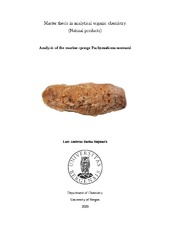| dc.description.abstract | Marine sponges are evolutionary some of the oldest multicellular organisms on earth and have in the last few decades attracted an increasing amount of attention. Sponges are simple filter feeders that host symbiotic microorganisms and have proven to be a prominent source of bioactive metabolites. In this thesis extracts from the marine sponge Pachymatisma normani was analysed to identify any of the metabolites produced by microorganisms residing on the sponge. The sponge was collected in Norwegian waters and there are very limited amounts of research regarding the sponge. P. normani was extracted using methanol and the crude extract was screened for compounds with UV-VIS absorption, using HPLC with a DAD-detector. Followed by choosing the most abundant compound as the primary target molecule. The UV-VIS absorbance for the target molecule was highest in the 330 nm window. Both liquid-liquid extraction and preparative-HPLC was used to purify and isolate a sample of the target molecule. The first extract was initially purified using liquid-liquid extraction and resulted in large quantities of precipitate of a white crystalline solid in the aqueous phase. The precipitation continued as the concentrated sample was stored. HPLC analysis of the purified sample resulted in a chromatogram containing additional peaks with UV-VIS absorption in the 330 nm window, indicating that the liquid-liquid extraction interfered with the sample. Preparative-HPLC with an UV-VIS detector fixed at 330 nm was used to purify the sample further. Followed by acquiring 1H-, COSY, HSQC and HMBC spectra of the sample. The target molecule was by no means isolated and the spectra contained a lot of impurities, with many overlapping peaks in the 1H-NMR spectrum. But there were some peaks in the aromatic region with decent resolution. Analysing the COSY spectrum revealed that there was an aromatic system with four proton signals, one was hidden inside a cluster of overlapping peaks. Through further analysis of the HSQC and HMBC spectra it was possible to piece together an aromatic compound with four protons and an extension containing two carbonyl groups, but there were still some blind spots to the structure. A second extraction and a new sample of the target molecule was prepared in the same fashion as before, except for liquid-liquid extraction. By not using liquid-liquid extraction to purify the sample it seemed to remain far more stable. There was significantly less of the white precipitate and no additional peaks in the HPLC analysis. A mass of 189.1 g/mol was acquired with MS, an uneven mass is often an indication that the structure contains a nitrogen atom. 1H-, COSY, HSQC, HMBC and 15N-HSQC spectra were recorded of the sample. The proton spectrum had better resolution and less overlap in the aromatic region. It did however contain additional peaks in the aromatic region along with a couple of NH peaks, but there was no correlation between the NH peaks and the target molecule. The sample from the second extraction provided spectra with better resolution and confirmed the elucidation done in previous sample. HR-MS was utilised to acquire an elemental composition and combined with the knowledge from the NMR elucidation the composition would have to be 12C101H714N116O3. 12C101H516O2 had been covered by NMR analysis, but there were several possible variables to apply 1H214N116O1 to the structure. Product ion scan was used to fragment the target molecule in order to pinpoint the position of the remaining atoms. Leading to a fragmentation pattern of [M+H] m/z 144.1 m/z 116.0 m/z 89.1. The heaviest fragment had a loss of 45, confirming the location of an acid group. From m/z 144.1 to m/z 116.0 there is a difference of 28 and fits the loss of second carbonyl group. From m/z 116.0 to m/z 89.1 there is a loss of 27, a loss that is typical for HCN and confirming the ring-location of the nitrogen atom. While also confirming that the target molecule would have to be kynurenic acid. Kynurenic acid is a known metabolite that is derived from tryptophan and has shown to have a neuroprotective effect. In humans a decreased level of kynurenic acid has been linked with depression, while elevated levels can be found in patients diagnosed with schizophrenia. Other studies have shown kynurenic acid to be a prominent antidote against neurotoxins. The compound has also been isolated from a sponge cultivated microbe once before. P. normani is suspected to have a hostile toxicity due to its barren surroundings, while the endosymbiotic microbes in the sponge produce a known neuroprotective agent. | en_US |
